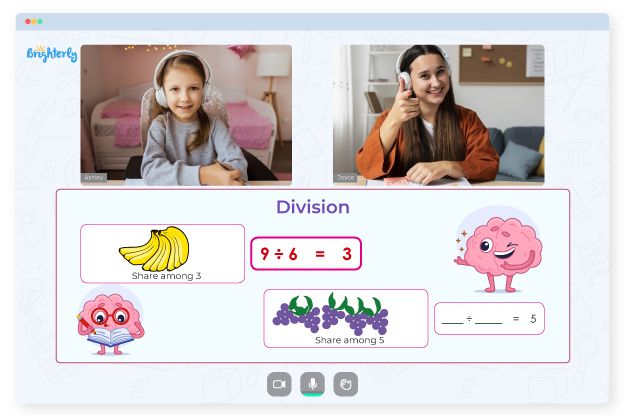Difference in Math – Definition With Examples
reviewed by Jo-ann Caballes
Updated on December 26, 2024
Difference refers to what makes one thing unlike another.
This topic covers the meaning of difference, how to find the difference in math, examples, and practice problems.
What is the Difference in Math?
Difference meaning in math is looking for how much a number or value is unlike the other. The difference is the result of subtracting the subtrahend from the minuend.
The minuend is the number we subtract from in an equation and the subtrahend is the number we subtract with. The difference symbol is placed between the two numbers and when we remove the subtrahend from the minuend, the result is called the difference.
Let’s observe the difference math example in the image below:
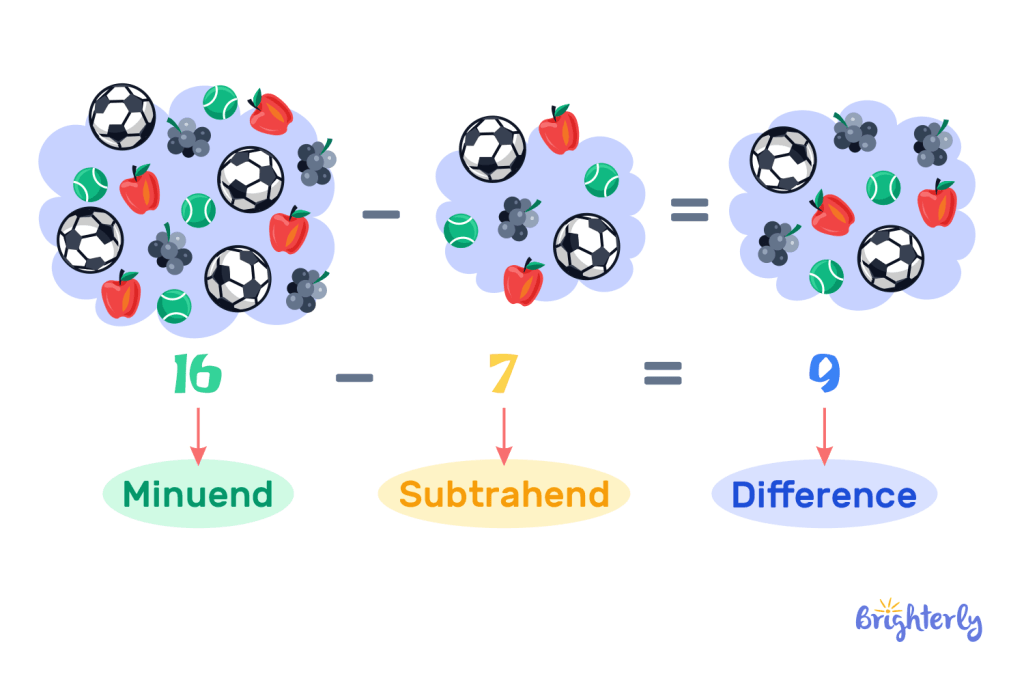
Definition of Difference in Math
We may define difference in math as the result of subtracting one value, quantity, or number from another. The difference between two or more numbers tells us how much gap they have apart.
When we add this gap to the lesser number, the result is the higher number in the equation. The symbol for difference is the minus sign (–).
Difference in Math Example
A difference example in math is the gap between 7 and 3. When we solve this as an equation:
7 – 3 = 4.
We find that the difference between the two numbers is 4.
We can find the difference math term between numbers through various means. One of these means is with a number line.
Finding the Difference between Numbers Using a Number Line
A number line is a straight, vertical line that has 0 at its center, positive numbers to the right, and negative numbers extending to the left.
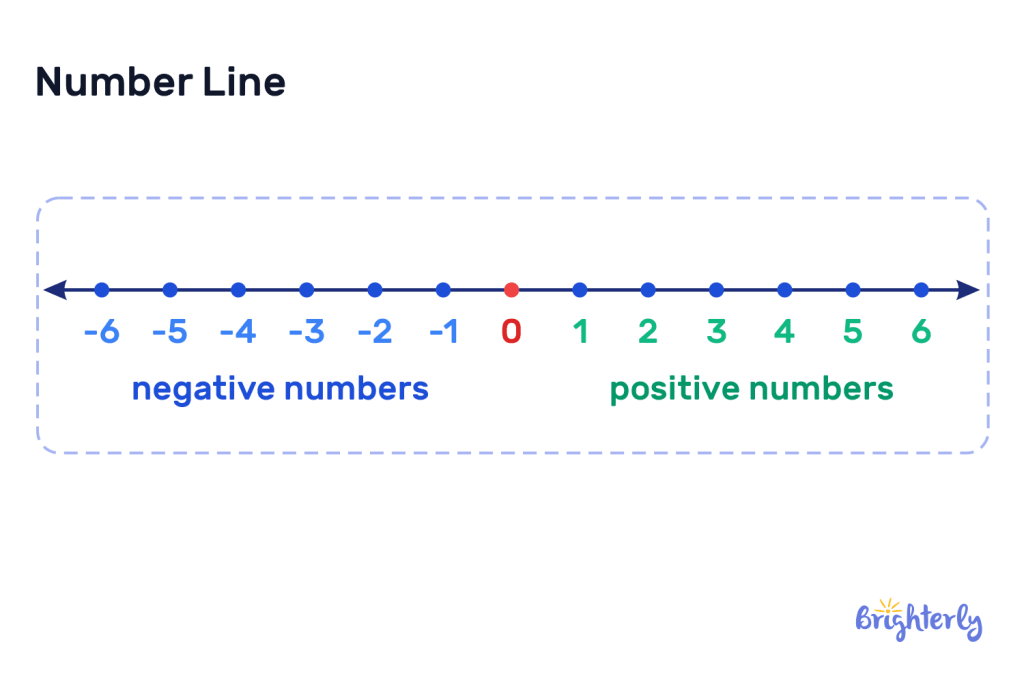
We can find the difference between smaller numbers with a number line by moving leftwards. We start with the minuend and move towards the left till we get to the subtrahend. Next, we count the amount of times we moved — that’s the difference.
For instance, to find the difference between 5 and 3 (5 – 3), we start from 5 and move to the left till we land on 3:
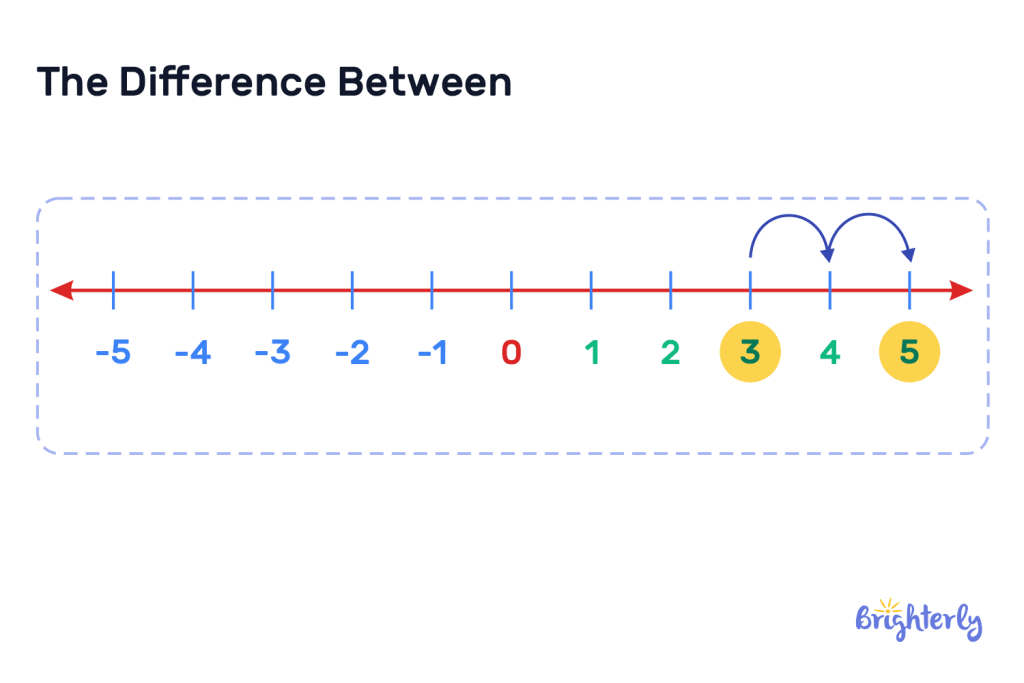
Per the image, we move towards the left 2 times. Therefore, 2 is the difference between 5 and 3.
Finding the Difference Between Two Numbers
The most common method of finding the difference between two numbers is through column subtraction. To do this, we begin by arranging the numbers on top of each other from the right, starting with the ones, then tens, hundreds, thousands, and so on. We then subtract from the rightmost side and write the result at the bottom. The final result is the difference of the two numbers.
For example, let’s find the difference between 476 and 213:
- Arrange the numbers vertically on top of each other:
H T O
4 7 6
–
2 1 3
- Subtract from the rightmost side:
4 7 6
–
2 1 3
———
2 6 3
———
- The result is the difference, which means the difference between 476 and 213 is 263.
However, when a digit in the subtrahend is larger than the corresponding digit in the minuend, we regroup or “borrow” from the next digit to be able to solve the problem.
Below is an example:
When solving the difference between 235 and 182 with the column method, we implement borrowing:
- We arrange the numbers vertically on top of each other:
H T O
2 3 5
–
1 8 2
- Then, subtract from the rightmost side. However, since we cannot subtract 8 from 3, we borrow from the next digit which is 2. By borrowing, we reduce the digit (2) by 1 and add 10 to the next digit (3).
12 13 5
–
1 8 2
———
0 5 3
———
Therefore, the difference between 235 and 182 is 53.
Finding the Difference between Two Decimal Numbers
We can find the difference between decimal numbers through the same column method we use for whole numbers, except with slight changes. Let’s find the difference between 34.7 and 28.16
- Arrange the numbers vertically on top of each other, and place the decimal point of the subtrahend directly under the decimal point of the minuend. We may also need to adjust the numbers if necessary. 34.7 needs to be adjusted to 34.70 so we can subtract 28.16 from it. Thus, our equation becomes:
3 4 . 7 0
–
2 8 . 1 6
- Subtract from the rightmost side as with whole numbers. We can also borrow from the next digit if necessary.
23 14 . 67 10
–
2 8 . 1 6
———————
0 6 . 5 4
———————
Finding the Difference between Two Fractions
How we find the difference in math between two fractions depends on whether or not they share the same denominator. If they do, they are called like fractions and all we have to do is subtract the numerators and retain the denominator. For instance, to find the difference between 5/4 – 3/4, we simply subtract 3 from 5 which is 2, so our difference is 2./4 . We can also simplify the difference to ½.
Subtracting unlike fractions
However, if the fractions do not share the same denominator, we find their difference by first finding the lowest common multiple of their denominators. Then, we multiply the numerator by the factor before proceeding to subtract.
Let’s find the difference between 5/6 – 3/14.
- First, we find the L.C.M of 6 and 14 using the prime factorization method.
6 = 2 × 3
14 = 2 × 7
Then we multiply the factors 2 × 3 × 7 = 42.
Therefore, the lowest common multiple of 6 and 14 is 42. We can now substitute the denominators to 42. You can learn more about L.C.M here.
- Multiply the numerators by the corresponding factors that turn the previous denominators to 42.
To do this, we simply divide 42 by the previous denominators. 5/6 = 42 ÷ 6 = 7 and 3/14 = 42 ÷ 14 = 3
Now we can multiply the numerators by the factors: 5 × 7 = 35 and 3 × 3 = 9
- Replace the numerators and denominators with the new values.
5/6 = 35/42
3/14 = 9/42
- Subtract as like fractions.
35/42 – 9/42 = 26/42 = 13/21.
Therefore, the difference between 5/6 – 3/14 is 13/21.
Solved Examples on Difference in Math
Solved math problem 1
What’s the difference of 8 and 5 on a number line?
Solution
First, we express the question as a math equation which is 8 – 5. Next, we draw the number line and count from 8 towards the left 5 times as:
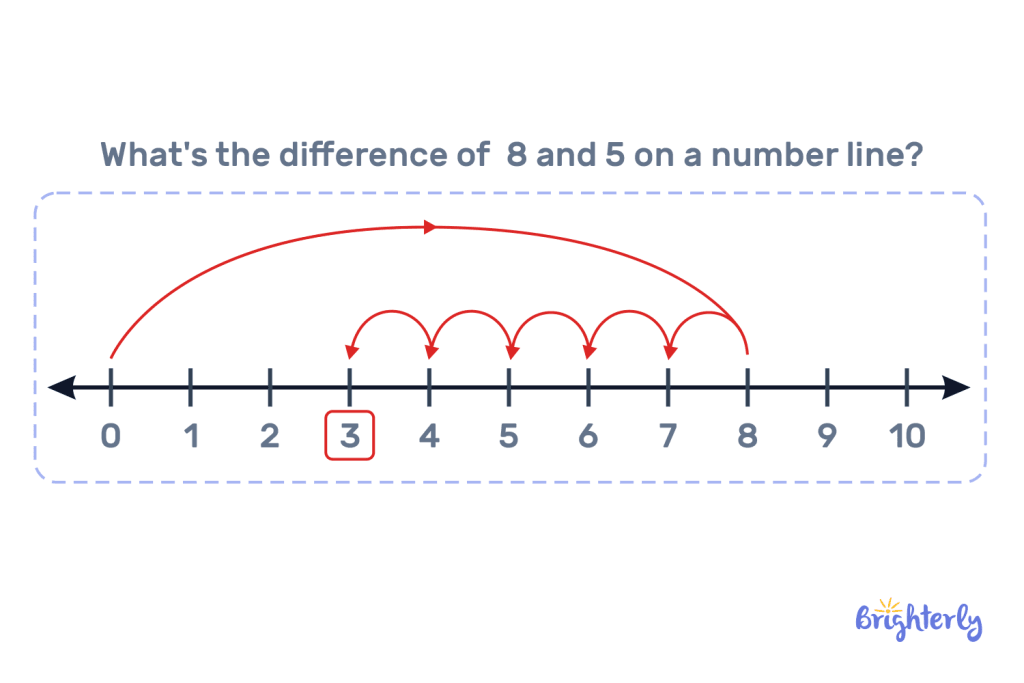
| Therefore, the difference of 8 and 5 is 3. |
Solved math problem 2
Cameron and his friends save $3,054 for a party but only spend $2,231. What is the difference between the two figures?
Solution
23 10 5 4
–
2 2 3 1
———————
0 8 2 3
———————
| This means Cameron and his friends have $823 left. |
Solved math problem 3
With the column method, find the difference between 53.74 and 42.63.
Solution
5 3 . 7 4
–
4 2 . 6 3
———————
1 1 . 1 1
———————
| Therefore, 11.11 is the difference between 53.74 and 42.63. |
Practice Problems on Difference in Math
Frequently Asked Questions on Difference in Math
What does difference mean in math?
Difference in math means the result of deducting a number or quantity from another.
How do I find the difference between two numbers?
You can find the difference between two numbers by deducting the subtrahend from the minuend.
Can difference be negative?
No. Difference cannot be negative. We find the difference by subtracting the smaller number from the larger number. However, when we subtract a larger number from a lesser number, the result is negative and this is called a negative result.
How do I find the difference between two fractions?
You may find the difference between two fractions by subtracting the numerators if the denominators are the same. If this isn’t the case, find the LCM of the fractions and then multiply the numerators by the quotient of the LCM. Finally, you subtract the numerators as with like fractions.
Is difference subtraction?
Difference is the result of subtracting two or more numbers. The difference in math symbol is also the same as the subtraction symbol (–)
Difference in Math: worksheets
Brighterly offers free worksheets to help improve your child’s understanding of difference with practice exercises. Here are some of them:
- Estimating sums and differences worksheets
- Subtraction with regrouping worksheets
- Subtracting fractions worksheets




